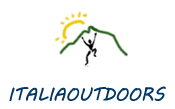One of the most interesting, and for me the most rewarding, hallmarks of our Bike the Wine Roads tours in Italy is to introduce the unique varietals we find along the way. The Italian wine landscape is amazingly diverse, with over 350 varieties officially documented by the Ministry of Agriculture, and over 500 more in circulation. Italy boasts an immense number of micro climates concentrated in a very small area, and we often find ourselves cycling through a locale in which a favorite traditional wine has found it’s perfect home, an integral part of the regional history and economy, but unheard of elsewhere. One example we find in the northeastern region of Trentino is a wonderful, full-bodied red - Teroldego Rotaliano.
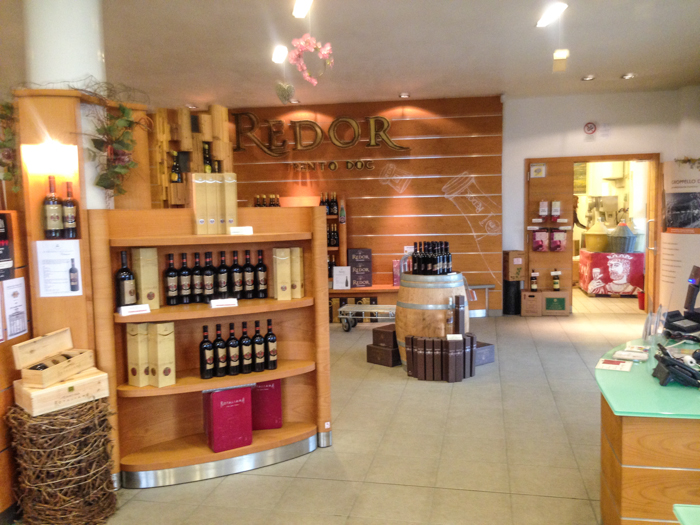
Teroldego is considered the king of Trentino wines. Local legend has it that the name itself derives from Tiroler Gold, the “gold from Tyrol”, which is how this wine was referred to at court in Vienna. However, it actually takes its name from its traditional method of cultivation, in which it is trained on a system of “tirelle” or wire harnesses. Recent DNA analysis has revealed that it is related to the French varietals Dureza and Syrah. Some authorities compare Teroldego to Zinfandel, with its spicy red fruits, but this is not accurate. Its acidity and snap makes it a versatile food wine.
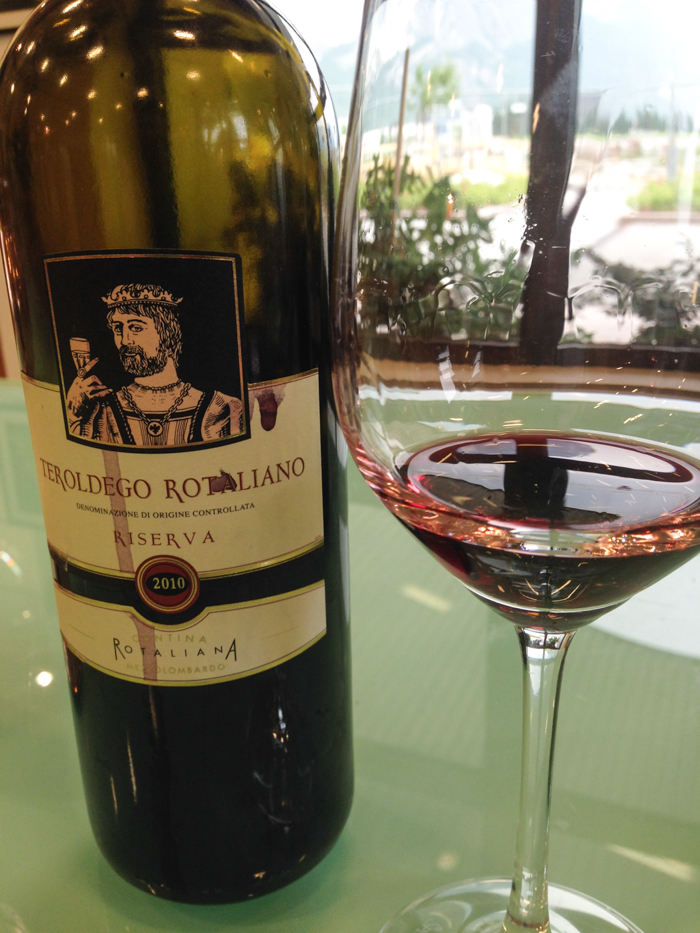
It flourishes only in the Piana Rotaliana, or Campo Rotaliano area, an alluvial plain just outside of the city of Trento between the Adige and Noce rivers. This plain possess an excellent micro climate for wine cultivation, which resullts in the specific characteristics of Teroldego - it’s full bodied flavor and rich bouquet. In spite of many efforts to reproduce the vineyards, environment, and irrigation in other regions, no one has successfully replicated these high quality wines anywhere else. For many years, it was used exclusively as a blending wine, mixed with sub-standard grapes to produce an only somewhat drinkable wine. Eventually, the producers realized the benefits of eliminating the inferior grapes and producing a high quality single varietal wine, and we are just beginning to see some of the benefits of this decision. Teroldego wines are quite distinctive, with intense fruit, full body, and a strong, dry taste.
During a recent visit to Trentino, I visited the Cantina Rotaliana in Mezzolombardo. Originally established in 1931, the winery’s production facility is now housed in brand new headquarters at the entrance to the town, equipped with the latest wine production equipment. Their objective is to maintain a successful balance between innovation and tradition, with modern facilities still located in the heart of Piana Rotaliana, land specifically suited to the cultivation of Teroldego.
The winery is a collaboration of close to 300 local growers, and produces a nice varied portfolio, with center stage reserved for it’s Teroldego. The Cantina also offers six whites, reds including Merlot, Cabernet and Lagrein, two Champagne sparkling wines produced under the Trentodoc, a red, rose and white blend under the name Thamè, a Gropello based red - another rare indiginous grape varietal from Trentino, and a selection of grappa.
During my visit, I began with a taste of one of their whites, a Muller Thurgau. It’s reputation locally is of a varietal that grows better than any other on high hills, it hails from vineyards belonging to Maso Saracini, on the high hills around Trento, and in Valle di Cembra. It is crisp and clean, with a grassy aroma. It is minerally and well-structured with a long lasting finish.
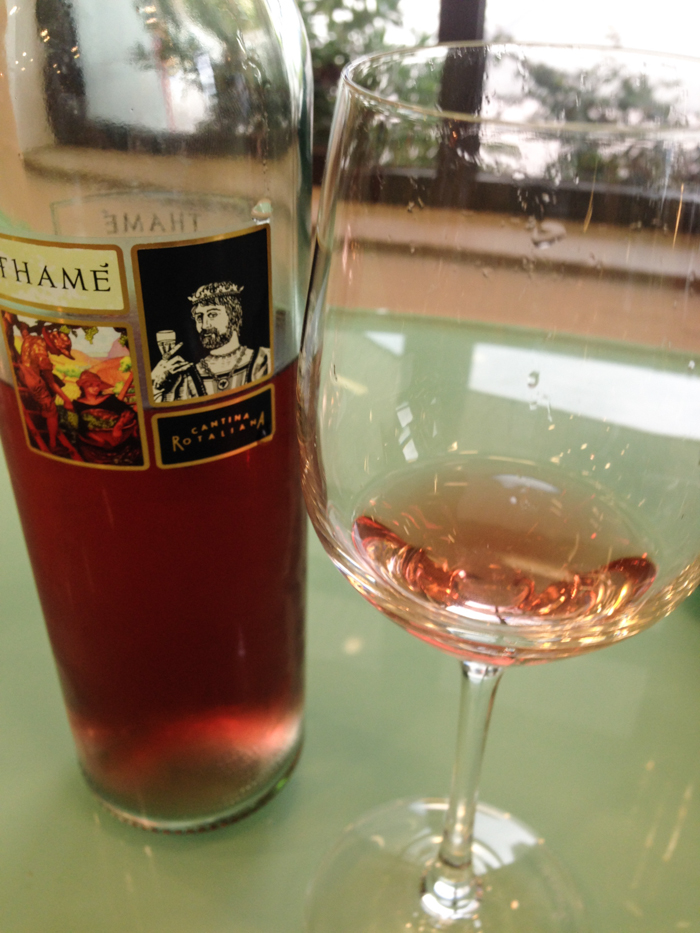
Next, I sampled one of their Thamè line, this one a rose, a blend of Teroldego and Lagrein, one of my other favorite varietals from Trentino. A perfect wine for a summer afternoon, clean and fresh, and flavors of cherry and berries, and floral notes. The higher acid content makes it a great food wine, pairing well with a cured meat antipasti typical of Trentino, or a vegetable risotto.
Moving on to their premier wines, I enjoyed first their 2010 Teroldego Riserva. To earn the "Reserve" designation, the wine must age a minimum of two years. This particular wine spends some of its time in large oak barrels, and the remainder in small oak casks called "barriques". Redolent with flavors of fresh berries, with a bit of herbs, spice and wood, it exhibits a slightly smoky nose and nicely balanced tannins. Robust and earthy, it offers an authentic feel.
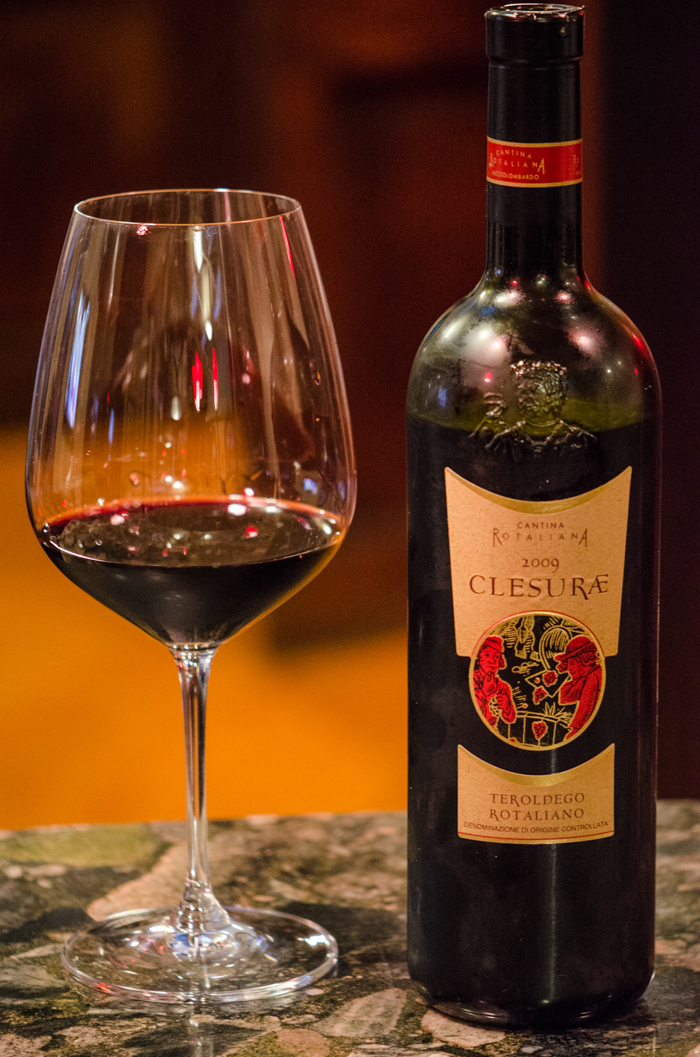
FInally, their starship offering, their Clesuræ Teroldego. The Clesuræ Project, as the winery refers to it, focuses on quality from the vine to the bottle, with the goal to produce a Teroldego wine of international class.
Clesuræ is a Latin term which evokes the ancient times when some open fields, considered the best for wine grape cultivation, were enclosed. Oenologist from the Cantina selected particular vineyards in the heart of the Campo Rotaliano, those known historically for producing the best wines. The vines here have an average age of 45 years. During the growing season, these vines are pruned to reduce the yield, producing grapes much more concentrated in flavor than the standard Teroldego.
During vinification, there are two additional ways in which Clesuræ differs from the traditional Teroldego Rotaliano. First of all, the malo-lactate fermentation process and the aging of this wine happen entirely in barriques (small French oak barrels with a capacity of 225 litres) where Clesuræ stays for 14-16 months. During this time this wine undergoes a series of transformations, due to the oak’s permeability. In fact, the oxygen gradually softens and smooths the vivacity of this red wine, making it more balanced.After its stay in the barriques the wine spends at least 8-10 months in bottle, again, longer than usual for a Teroldego.
The results were very successful - the 1999 and 2002 obtained one of the most prestigious awards for an Italian wine producer: Tre bicchieri from the Gambero Rosso Guida Vini d’Italia.
Dark ruby red, this has an amazingly spicy and complex nose. Strong flavors of cherry fruit and berries, with notes of plum, oak and earth. A toasty, lingering finish with delightful balanced tannins. An elegant wine that will age well. A very polished wine, that succeeds very well in displaying the true potential of this unique varietal Would pair wonderfully with a hearty braised meat, or sharp aged cheese.
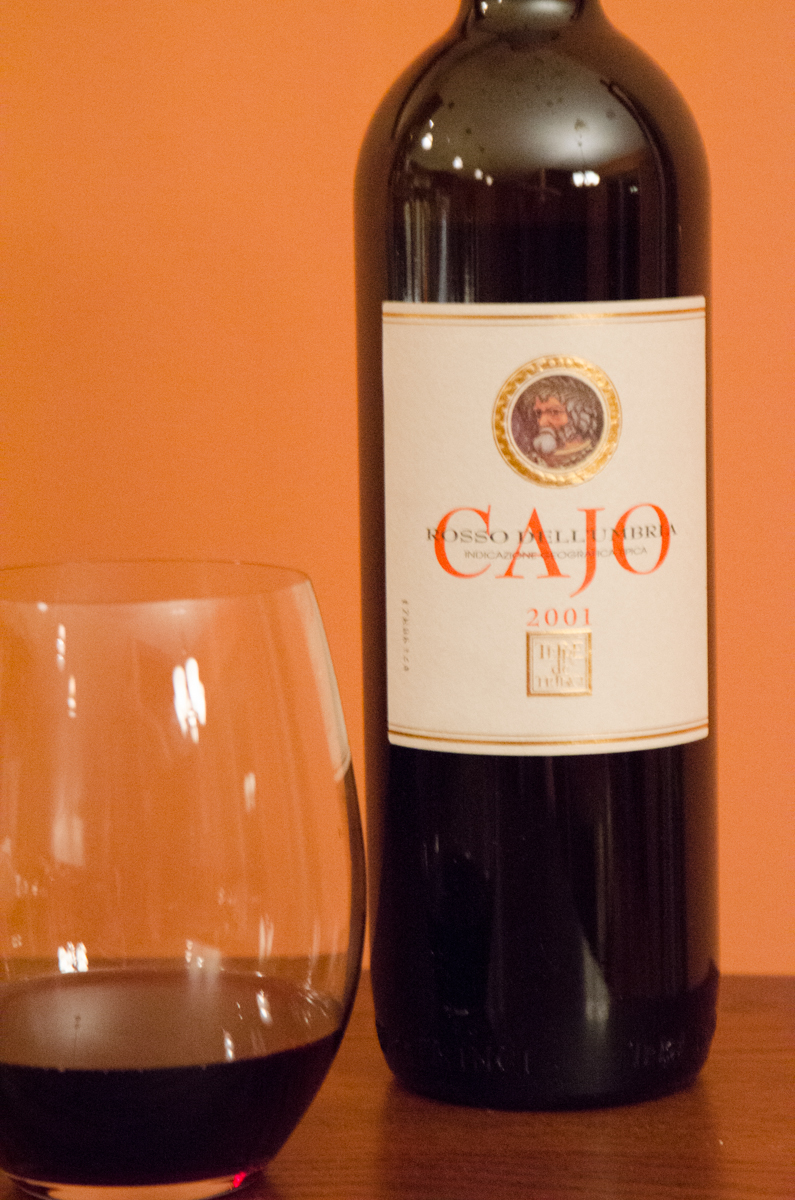 The hillsides of Umbria are covered with expanses of vineyards and olive orchards. Around the town on Montefalco, most of the vineyards are dedicated to their natvie black grape, Sagrantino. Rarely seen outside of Umbria, Sagrantino grapes produce robust wines, with powerful tannins that, in the right hands, result in wines with great depth and potential for aging.
The hillsides of Umbria are covered with expanses of vineyards and olive orchards. Around the town on Montefalco, most of the vineyards are dedicated to their natvie black grape, Sagrantino. Rarely seen outside of Umbria, Sagrantino grapes produce robust wines, with powerful tannins that, in the right hands, result in wines with great depth and potential for aging.
Terre de’ Trinci, located in Foligno, has been producing Sagrantino based wines since 1950, initially going into business as a way to preserved this wine and it’s place in the local traditions and culture. In the early 1960’s, they became the first producer to make and bottle the ‘dry’ version of this wine.
In 1992, Montefalco Sagrantino was granted DOCG status, and Terre de’ Trinci rededicated itself to it’s production with a renovation of it’s facilities, modernization, development of quality certifications and more emphasis on the aging process. Today, they continue to work to combine both innovation and tradition, as they continue to make the classic Sagrantino, as they introduce more modern style wines, blending Sagrantino with international varietals such as Cabernet and Merlot.
Their 2001 Cajo Rosso dell'Umbria is one excellent example of their modern style wines. A blend of equal parts Cabernet Sauvignon, Merlot and Sagrantino, it is a deep ruby red, with intense aromas of dark cherry, fig, with vegetal notes. It is both fruity and earthy, with hints of tobacco. Extremely smooth and well balanced between the fruit, a nice acidity, and some tannins to finish.
Enjoy with pasta and a meat ragu, grilled meats, or medium aged cheeses.
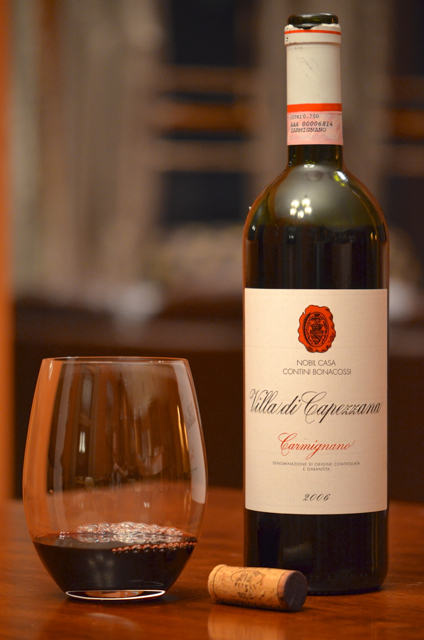 One of the most distinguished of the Tuscan wine zones, the Carmignano DOCG is barely 100 hectares, and consists of only 20 producers in total. The leading producer in this appellation is Capezzana, an estate that is responsible for nearly 50% of this regions’ total production. The Capezzana estate itself is over 1200 years old, and has been producing both wine and olive oil since 804 AD. Today the estate is owned by the Contini Bonacossi family, who purchased it, and several surrounding farms, in the 1920s. In 1932, when the modern day Chianti Classico region was defined, this area was included in the Chianti Montalbano sub-zone. The Bonacossi’s, not wishing the distinctive nature of their wines to be lost in the larger population of Chianti, successfully fought for DOC, and then DOCG recognition, under the original Carmignano name.
One of the most distinguished of the Tuscan wine zones, the Carmignano DOCG is barely 100 hectares, and consists of only 20 producers in total. The leading producer in this appellation is Capezzana, an estate that is responsible for nearly 50% of this regions’ total production. The Capezzana estate itself is over 1200 years old, and has been producing both wine and olive oil since 804 AD. Today the estate is owned by the Contini Bonacossi family, who purchased it, and several surrounding farms, in the 1920s. In 1932, when the modern day Chianti Classico region was defined, this area was included in the Chianti Montalbano sub-zone. The Bonacossi’s, not wishing the distinctive nature of their wines to be lost in the larger population of Chianti, successfully fought for DOC, and then DOCG recognition, under the original Carmignano name.
Today the Bonacossi family produces both wines and olive oils on their estate. In addition to their Villa di Capezzana Carmignano DOCG wine, they make a younger version of the Carmignano, a Barco Reale, with it’s own DOC status. They also offer a Bordeaux style wine, their Ghiaie della Furba, as well as Trebbiano based whites, a Vin Santo, and a grappa.
I have tasted the 2006 Villa di Capezzana Carmignano. Carmignano is a Sangiovese based wine, with a bit of Cabernet Sauvignon or Cabernet France; the first ‘Super Tuscan’, so to speak. The 2006 Villa di Capezzana Carmignano is 80% Sangiovese, 20% Cabernet Sauvignon. Cultivated in hillside vineyards in Carmignano, this wine is aged in french oak barrels for a year, then an additional year in the bottle. It is a dark ruby red color, with aromas of dark cherry and fruit, leather, and smoke. Medium-bodied, and full of fruit flavor, spicy, it is a beautiful and elegant wine. Perfect with meat dishes, aged cheeses, and pastas with meat ragu.
Arnaldo Caprai is one of the largest producers of Sagrantino wine. Sagrantino is a grape variety that is found almost exclusively in Umbria, around the village of Montefalco. Only 250 acres total are dedicated to production of this grape, in the hands of a mere 25 total producers.
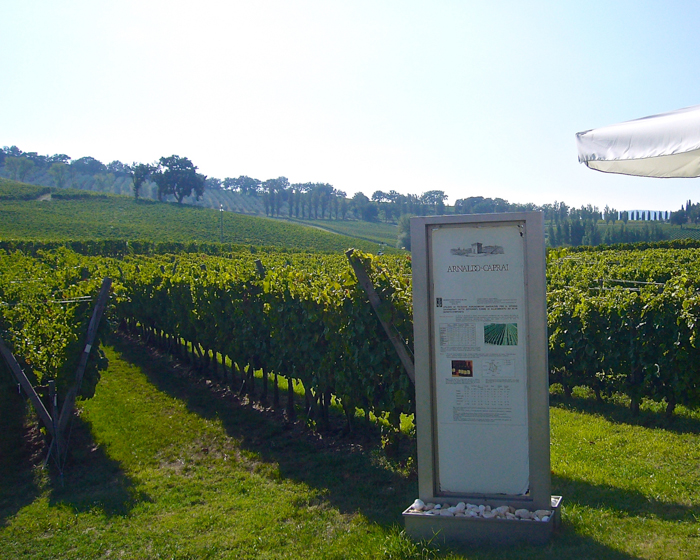
Sagrantino does not resemble any other grape found in this area of Italy, and the origins of the grape are still unknown. Some experts believe it originated in Montefalco, while others believe it came from Asia Minor, brought to Umbria by the followers of Saint Francis of Assisi. The name Sagrantino comes from Sacramenti, the red wine used during religious services.
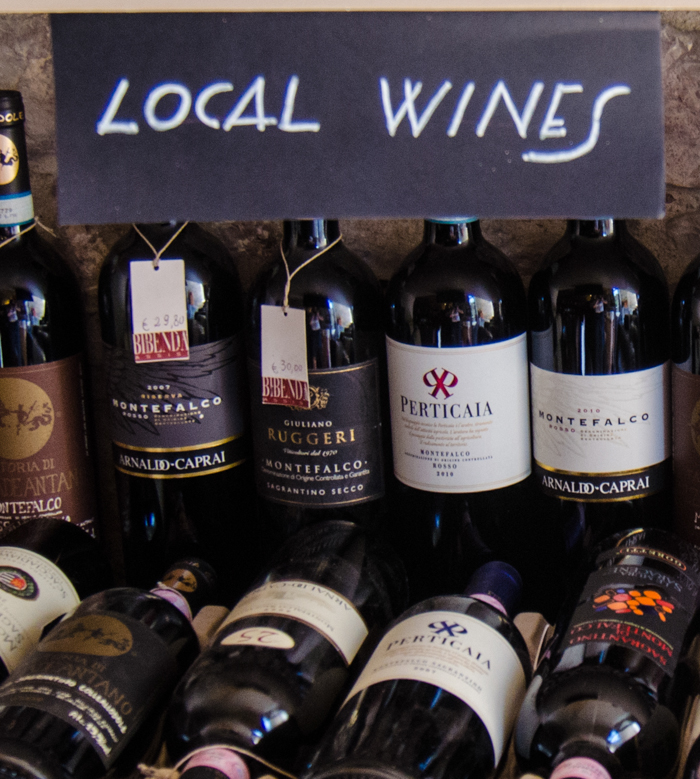
As early as 1200 there is written evidence of wine production in the areas around Montefalco. Throughout the Renaissance the wine’s reputation for quality spread throughout Italy. Wine-growing was such a serious matter that in 1622 Cardinal Boncompagni establishes "the death penalty by hanging for those who are found to cut a grape vine".
However, in the early 1900’s the use of this grape declines, and the varietal became almost extinct in the 1960s. In 1971 Arnaldo Caprai, a successful textile businessman, bought a Val di Maggio estate to fulfill his dream of producing his own wine with the local Sagrantino. Over the years he expanded his holdings, and added modern production facilities. His son Marco Caprai started managing the winery in 1988, with an equal passion and determination to the production of top quality wines. Today, the dedication to quality production of Sagrantino wines continue, and Caprai, along with a few other Montefalco producers, have saved this wine from extinction.
Caprai’s flagship Sagrantino is their “Sagrantino di Montefalco “25 Anni”, created in 1993 to celebrate the winery’s 25th anniversary. Sagrantino is one of the most tannic varietals available, requiring a bit of finesse in the wine making process to keep them from overwhelming the wine. Decanting is strongly recommended. This wine has been awarded many accolades, including “Best Italian Wine” and 3 and 4 Grappoli from Gambero Rosso.
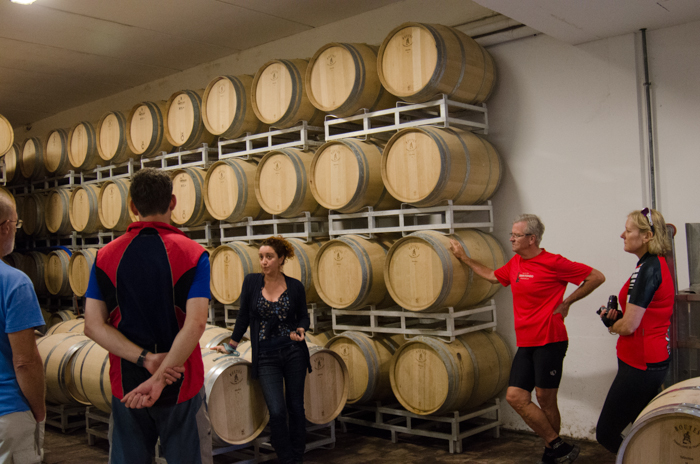
This wine is robust and intense, yet elegant. Spicy black cherries, dried fruit and currant mix with licorice, spice, and smoke. Made exclusively from Sagrantino grapes, it undergoes 24-26 months aging in French oak barrique and minimum of 6 months aging in the bottle. It’s aging potential is great, 15-20 years. A great wine to be paired with roasted or grilled of lamb, game, and other meats. Black truffle and aged cheeses are also lovely partners to match the tannins and body.
Caprai also produces a slightly less robust Sagrantino, their Montefalco Sagrantino DOCG Collepiano. Also 100% Sagrantino, and again aged 24-26 months in French oak and a minimum 6 months in the bottle. A dark bouquet of red fruit and raisins, with spicy and earth. It’s aging potential is 10-15 years, and pairs well with roasted and braised meats, game, and aged cheeses.
The Montefalco Rosso DOC wine is a more subdued introduction to Sagrantino, a blend of 70% Sangiovese with 15% Sagrantino and 15% Merlot. A rich ruby red, full bodied and dry, with a persistent finish. Elegant, with flavors and aromas of red berries, spice and tobacco. It is aged 12 months in wood (70% in Slovenian barrels; 30% in French oak barrique), and a minimum 4 months aging in bottle. It can be enjoyed on its‘ own, or with red or light meats, meat antipasti, and aged cheeses.
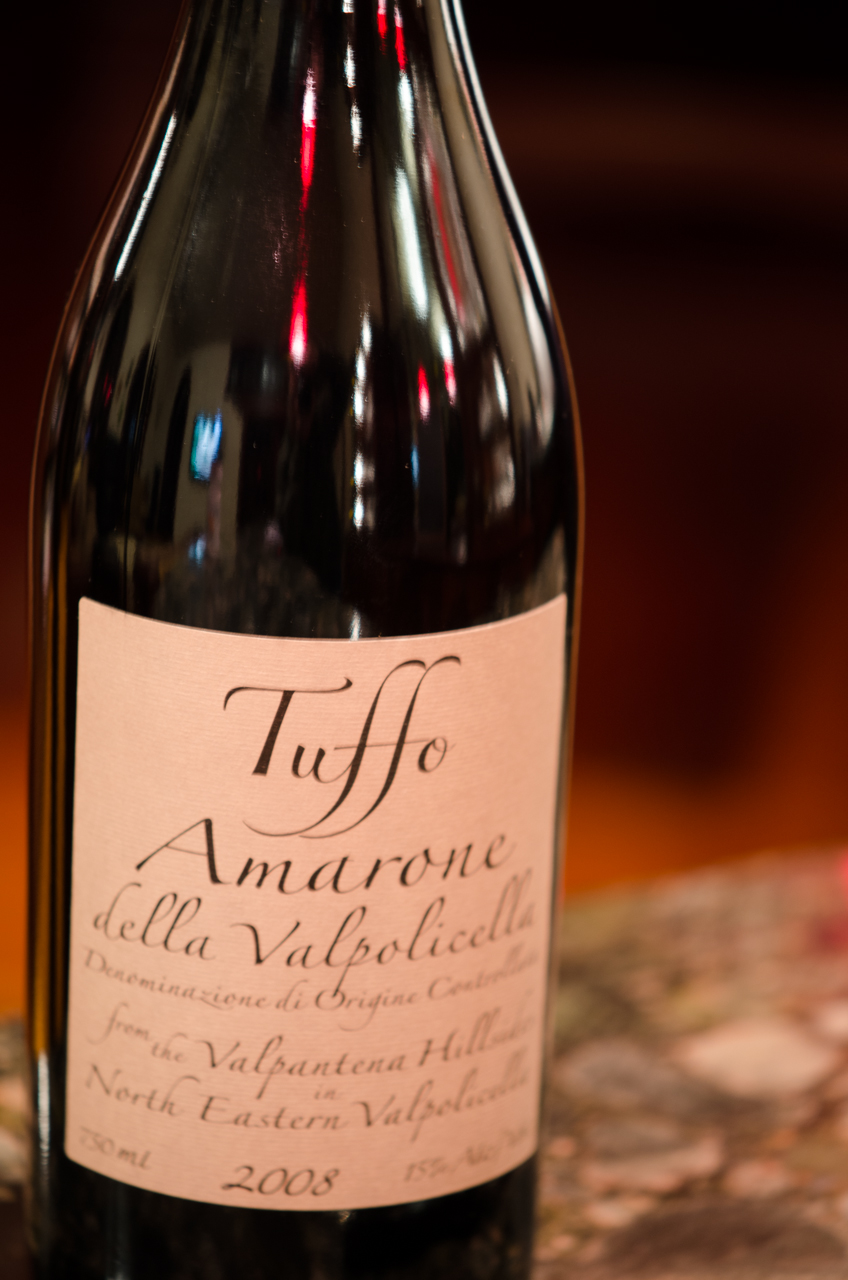 On a trip to New York City, I found this reasonably priced Amarone at a wine shop. It was a new producer to me, and my quest to learn something about the winery itself came up quite empty. I guess I will have to do my research in person, on my next trip to the region!
On a trip to New York City, I found this reasonably priced Amarone at a wine shop. It was a new producer to me, and my quest to learn something about the winery itself came up quite empty. I guess I will have to do my research in person, on my next trip to the region!
This Amarone is a blend of 65% Corvina, 25% Rondinella, 5% Corvinone, and 5% Negrara. The grapes are cultivated in vineyards located on the hillsides of Valpantena, in the northeast corner of the Valpolicella region. Valpantena is a valley running from Verona, north up into the Lessini mountains. Tuffo also produces Valpolicella and Soave wines, as well as a Pinot Grigio.
Tuffo first released an Amarone in 1959. Their Amarone is obtained from the choicest bunches of grapes, which are harvested by hand, separated as not to touch and left to dry in wooden racks for 90 days. During this drying process, called appassimento, the water within the grapes evaporates, leaving concentrated fruit extract inside each grape. After this raisining, the grapes loose up to 30 - 40 % of their weight, and increase their sugar extracts by 25 - 30%. At the end of January the grapes are pressed and left to ferment for 25 - 30 days.
After the final press the wine is racked into stainless steel tanks where malolactic fermentation takes place. Afterwards, the wine is aged for 18 - 20 months in a combination of small French oak barrels and Italian cherry wood casks before going into bottle. Once in bottle, with wine ages another 2 - 4 months before being released.
The Tuffo 2008 Amarone is deep ruby-red in color. The nose is lively with scents of dark berries, currants, vanilla and almonds. An elegant, full-bodied wine with both a robust fruitiness and nicely structured tannins, followed by a persistent finish. An excellent pairing with roasts, braised meats, and rich cheeses.


